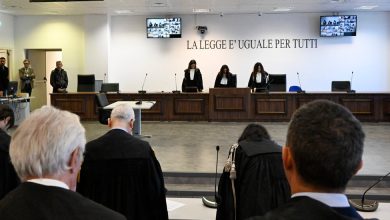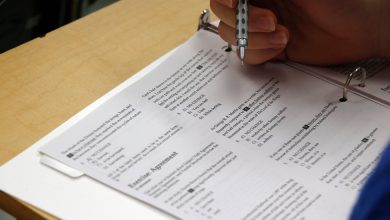This Venice Biennale Has a New Star: Women

The Venice Biennale, the world’s longest-running major survey of contemporary art, will reconvene this weekend after a yearlong postponement because of the pandemic. Barring another coronavirus surge, the 59th edition of the world’s oldest international exhibition, which opens to the public on Saturday and runs through Nov. 27, should attract hundreds of thousands of visitors.
But while the Biennale’s popularity is beyond dispute, its track record in terms of gender representation has been lackluster. For the last 127 years, its flagship show — the International Art Exhibition — has been curated mainly by men, and has featured a predominantly male roster of artists. As recently as 1995, roughly nine out of 10 artists in the exhibition, curated by Jean Clair, were men. It was not until 2019, under the artistic director Ralph Rugoff, that gender parity was achieved for the first time.
This year, the male-female ratio is being radically reversed. The Biennale’s Italian-born artistic director, Cecilia Alemani, the director and chief curator of New York’s High Line Art, has chosen 213 artists for the central exhibition — and roughly nine out of 10 are women.
Ms. Alemani, the first Italian woman to curate the event, is making up for more than a century of low female visibility by filling her show with female artists, most of whom have never shown work at the Biennale. Her title for the exhibition, “The Milk of Dreams,” is borrowed from that of a book by the British-born Mexican Surrealist painter Leonora Carrington (1917-2011), one of the many overlooked women whose contribution to art history will be honored.
“We have been obscuring the work of women artists in an unfortunately dramatic way,” Ms. Alemani said in a recent video interview.
She added that, despite the “radical changes” brought by the #MeToo movement in the last few years, her native country, Italy, remained “very, very sexist.” The Biennale, she said, was “not a representation of our society anymore.”
“It’s important to call these things out,” she said.
Art-world insiders have applauded Ms. Alemani’s women-dominated Biennale.
“It is bold and smart and overdue,” said Allan Schwartzman, a New York-based art adviser and the principal of Schwartzman&. “She’s breaking a mold.”
He said that though feminism has affected art more “than virtually anything in the postwar period” — introducing a more intimate scale and brighter colors to painting and sculpture, as well as opening a path for the “personal and diaristic” — its impact has not been sufficiently acknowledged by scholars, museums and the art market. He said he hoped this year’s Biennale would present the work of women “as forming a somewhat different history.”
Male artists exhibiting in Venice this year have embraced the influx of women. “I have been fascinated to see the art world become more open over the years,” said Raqib Shaw, an Indian-born artist based in London who is exhibiting new work inspired by Italian masterpieces at the International Gallery of Modern Art at the Ca’ Pesaro in Venice. “It is great that the majority of artists are women — long overdue.”
The Biennale takes place on two sprawling sites: the Giardini, Venice’s public park, and the Arsenale, the former shipyards and armories that provided the Venetian Republic with its naval power for centuries. Both sites are speckled with national pavilions that serve as cultural outposts for the countries they represent. There are a total of 80 national pavilions this year, with five countries participating for the first time: Cameroon, Namibia, Nepal, Oman and Uganda.
The pavilions always reflect the global geopolitical situation, and this year, all eyes will be on the Ukrainian pavilion and its artist, Pavlo Makov, who will present a version of his work “The Fountain of Exhaustion,” an installation of bronze funnels spouting water that he conceived in 1995 but never fully realized.
Ukraine’s inclusion in the 2022 Biennale was nearly compromised by Russia’s invasion of the country on Feb. 24. But then, hours after the invasion, a curator of the Ukrainian pavilion, Maria Lanko, a founder and curator of the Naked Room gallery in Kyiv, loaded the work’s main components into the trunk of her car and set off on the long drive to Venice.
“We started a new calendar that day,” Ms. Lanko said at the Talking Galleries conference in New York this month. “Now, we only count the days of the war.”
The invasion ended Russia’s own participation in the Biennale after the Russian pavilion’s Lithuanian curator — and the artists who were set to show work — walked out on Feb. 27, effectively shuttering the space. The next day, the Biennale issued a statement noting that the curator and artists had resigned, “thereby canceling the participation in the 59th International Art Exhibition.”
Other national pavilions will be making history in quieter ways. The United States will be represented for the first time by a Black woman, Simone Leigh. And the United Kingdom will be represented for the first time by a Black woman, Sonia Boyce.
Though Ms. Boyce welcomed the accolade, she said it was something of a mixed blessing.
“I’m very fortunate to be recognized for the work I’ve been doing,” she said in a phone interview. “But, in terms of being first, it really does speak of the large-scale inequities that there are in the visual arts.”
Ms. Boyce also questioned the notion of being identified as a “representative,” because she said her selection might be viewed as “not a question of individual merits, but of representative merits.”
Over the last few decades, in tandem with the art market explosion, Venice has become a place to see and to be seen, a stomping ground for the extremely rich, who moor their glimmering yachts in the Grand Canal. The preview days at the Biennale have turned into such a parade of wealth and glitter that some art lovers — like Mr. Schwartzman — skip them altogether.
“What’s changed with the Biennale, particularly at the opening, is the extent to which it’s become as much about a fashion and celebrity world as an art world,” he said.
Some of the artists exhibiting at this year’s event acknowledged that the wealth and glamour swirling around Venice could be intoxicating.
“As an artist, it always takes resilience and clarity not to be seduced by success or big money, whether in Venice or elsewhere,” said the German artist Katharina Grosse, who will be exhibiting a site-specific work inside the Espace Louis Vuitton in Venice that consists of an image of her hands printed on a mesh metal fabric.
Still, she wrote in an email, the Biennale has, for a century, been a “dynamic and revelatory environment” for the arts — and it remains so.
“If Venice were only to be about collectors on yachts,” she added, “nobody would come.”





